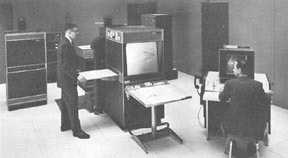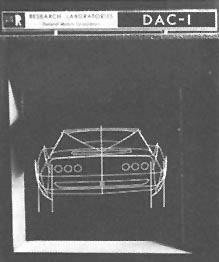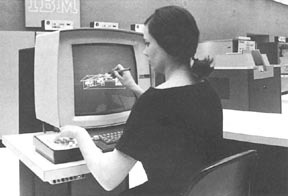Chapter 3: The computer graphics industry evolves
3.3 General Motors DAC

Beginning in 1959, General Motors and IBM embarked on a project to create a unified computer assisted design environment. Originally called “Digital Design”, its name was changed to DAC, for Design Augmented by Computer. It was formally disclosed at the 1964 Fall Joint Computer Conference. Called DAC-1, the first system was built by IBM using specifications provided by a team of engineers from General Motors, including Fred Krull and Dr. Patrick Hanratty, who later founded the CADD company MCS. The display system, sometimes considered as the first CAD system, introduced transformations on geometric objects for display, including rotation and zoom, and a no-display (later called “clipping“) function (see automobile image at the right). It used a light pencil, instead of the commonly used light gun or light pen. This device read coordinate voltages from a conductive transparent sheet that was positioned over the IBM Alpine display head.

The Joint Computer Conference was held twice a year in Fall and Spring, and was a conference of a federation of the major computer societies, the American Federation of Information Processing Societies (AFIPS). It was held until 1973 when it was replaced by the National Computer Conference.

The DAC-1 display console was connected to an IBM 7094 computer. It utilized a very creative group design collaboration system, which consisted of a photo “readout” system connected to a projection device. When collaboration on the design drawing was desired, the operator could select a view which would be displayed on an auxiliary CRT film recorder, and it would be scanned and quickly processed, and could then be projected onto the screen. These components are all shown in the image of the system on the previous page. DAC-1 also could input drawings from other sources, such as traditional hand drawings, using a computer controlled film reader.
Movie 3.3 General Motors DAC-1 Demo
This excerpt from a DAC demonstration video shows General Motors engineers interacting with the design system.
The technology developed in the DAC project at GM resulted in the development by IBM of (among other things) the workhorse IBM 2250 graphics display, which was the interface with the IBM 1130 and 360 mainframes, and which was one of the most commonly used graphics displays of the 1960s and early 1970s. The 2250 was a vector device with 1024×1024 addressable resolution, a 12×12 inch display screen, and a .0200 inch spot size. The model 1 had a storage buffer of 8,192 bytes and a cycle time of 4 ms per byte. It had 64 non-changable characters in a built in character generator for on-screen labeling. Like many display units to follow, the 2250 had a function keyboard, an alphanumeric keyboard and a light pen. Its basic cost was around $100K. More detailed information can be obtained from an article by Arthur Appel, et al from IBM in 1968.

IBM developed three graphics related devices for DAC-1 — the 2250 display device, the 2280 film recorder, and the 2281 film scanner. The last two were discontinued because they were not received well in the industry.
Toward a Machine with Interactive Skills, from Understanding Computers: Computer Images, Time-Life Books, 1986
The Origin of Computer Graphics within General Motors, Fred Krull, IEEE Annals of the History of Computing, Fall 1994 (Vol. 16, No. 3); Interactive Graphics for Computer-Aided Design, by M. David Prince, Addison Wesley, 1971.
Aspects of Display Technology, Arthur Appel, IBM Systems Journal, Volume 7, Numbers 3/4, Page 176 (1968)
